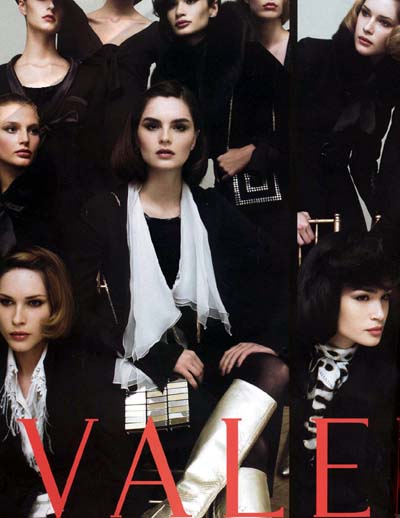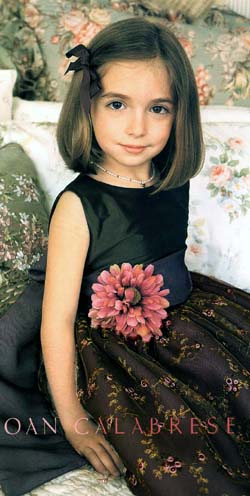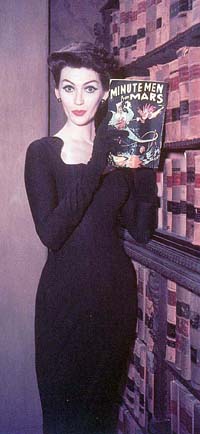 |
Manners, Customs, Clothing
A Black-Out on Black
Marian T. Horvat, Ph.D.
A lady wrote to the fashion editor of the Los Angeles Times and said that she was confused. She attended a church wedding on a hot sunny afternoon here in California between Christmas and New Year’s Day and 95% of the women were wearing black. Even the bridesmaids’ dresses were black. It looked like a funeral. A few days later, she went to a funeral and found the majority of ladies were sporting bright colored outfits. Is this appropriate? she asked.

Young people choose black - for work, pleasure, leisure, even weddings... |
What a perfect example of how completely upside-down the modern world has become. We wear the mourning colors to weddings and rejoicing colors to funerals – and no one seems sure if this should occasion shock or disapproval. After all, anything goes since the ‘60s.
Now granted, recent statistics show that half of the marriages in the United States will end in divorce, but it hardly seems appropriate to don apparel that presages such doom and gloom figures instead of wearing charming colorful dress or rich jewel tones.
True, more and more post-Vatican II liberal priests are raising all the deceased to the rank of saint in joyous funeral sermons. Even if these dubious judgments were true, the bright colors clash with the expression of the natural grief of those who mourn the death of a loved one. This new liberal "open-doors" policy of Heaven seems to be the rationale for the latest “smart” way to dress to “celebrate” the “passing” of a loved one. But Catholics know that this does not change the grim reality of the grave finality of death when a man stands before the dread judgment seat of God.

Girls used to wear pastels and colors. Now they are wearing black |
All this signifies a disregard for the traditions of Western Christian Civilization, according to which colors have a symbolic significance. White manifests virginity, purity and innocence, black and dark violet are used for mourning.
Widows traditionally donned black for a certain period after the death of their husbands as a sign of mourning. And sometimes they would adopt such clothing until they died, as a gesture that they, like those who embraced religious life, had died to the pleasures of the world and the happiness of marriage in order to constitute a family. To this day, if you visit the charming fishing village of Nazaré in Portugal, you can still see many of the ladies and girls wearing the exotic and picturesque layered skirts used for centuries by women who, at day’s end, would meet their husbands at the seashore to help them drag in their boats and nets. Yet here and there is still a figure darkened by black clothing, a concrete reminder that some tragedy occurred in the struggle between man and the finally invincible sea.
When did black begin to be considered fashionable wear in the West? It seems to me that we can follow two distinct channels of acceptance. The first upsurge to make black acceptable came from the fashion houses of Paris and London and was directed at the fashion elites - the rich, the glamorous and the chic. Chanel’s revolutionary “little black dress” for the elite lady of style entered the fashion scene in the post war period.
In the ‘50s Christian Dior made popular the black afternoon dress and jacket, but again, only for the wealthy and super fashion conscious. However, it wasn't long before the black dress lost its revolutionary tone and had become a staple at any fashionable gathering. By the early '90s it took a lot more to startle a gathering than a scintillating black dress, and it became quite the fashion at high society London and Paris parties to masquerade in Frankenstein-Marilyn Manson black costumes with clearly Satanic tones. This is not to say that everyone who, for fun or shock-value, joins in the fad is involved in outright Satanism. It is merely to point out where the first channel seems to flow.

Christian Dior made the black dress a fashion item in the '50s |
The second channel flowed through the beatnik and artsy-academic circles to reach the university students, the middle class, and everyone else. In the '60s the beatniks made black the core color of what became known as “Beat style.” Black became the favored color among artists and intellectuals. The black apparel of the reactionaries not infrequently seemed to accompany the popular revolutionary longings of the day and to provide fertile soil for fermenting utopic communist and socialist ideas. In the ‘60s, modern dancers wore black tights and leotards, while painters, musicians, “hip” professors and liberal Jesuit priests wore black turtlenecks, which were considered cool and non-conformist. This rebel Bohemian black was very different from Chanel’s “little black dress,” which had become the uniform for respectability.
In the last decades, the color black has become co-natural with the mushrooming occult and Satanist sects, as well as the metallic MTV rock culture. Black is the color of choice for the Dungeons and Dragons aficionados, skinheads and youth gangs. Middle school and high school principals and teachers are instructed to be watch out for students who consistently wear black clothing as an identifying mark for disturbed young people capable of inflicting violence on themselves – or others (e.g. the Columbine incident). And so the second channel appear to reach its course and flow with the first into the same occult pool.
For one who still believes that colors have meanings, one could interpret this trend toward the color black to represent the anxieties, insecurities, depressions, and imbalances of every kind that plague modern society. This obsession with black clothing, especially among the youth, is a concrete sign of our dark, troubled and mournful days, times when the young become old too quickly and grieve too soon for lost childhood and vanished innocence. That is the best and perhaps more poetic interpretation. At worst, it is surely a kind of symbol of the dismal triumph of Satanism and the occult.

Today the color black is co-natural with the occult, Satanist sects and heavy rock bands |
Someone is sure to object: I only wear black because it is slimming, and I need all the help I can get. That was my excuse as I examined my own closet recently and saw a surprising preponderance of black garments. It was sobering, no pun intended. I made a resolution to begin a personal black-out on black, to avoid buying new articles of clothing in black for daily wear. How can I lecture youth on their ghoulish and slavish slavery to the popular garb of the day if my own apparel is hardly less somber and dreary? This seems a very small gesture to make to begin to counter a fashion trend that I think is, at base, unhealthy and revolutionary. Another thing. I won’t wear black to weddings, or bright colors to funerals.
Clothing is more than a reflection of personal style. It is a highly symbolic way of showing respect for others and illustrating that we understand the meaning and importance of social situations, and especially those in which we share our joy and sympathy with those we love.
By the way, for those who are wondering how Los Angeles fashion policewoman Jeannine Stein responded to the confused reader, you might be surprised to hear that even in “everything goes” Holllywood, there remains a strain of good sense. She had no sympathy for those who wear black to weddings and bright colors to funerals, and made a plea to ladies of style to follow tradition because clothing does, in fact, stand for something. (Los Angeles Times, Living Section, Jan 12 and 26, 2001).

Posted February 14, 2003

Related Works of Interest
|
|
Manners | Cultural | Home | Books | CDs | Search | Contact Us | Donate

© 2002- Tradition in Action, Inc. All Rights Reserved
|
 |
|